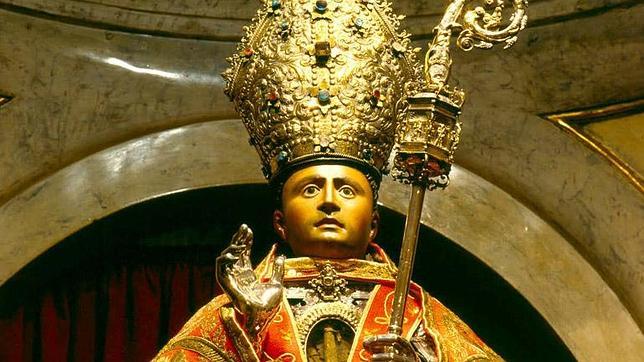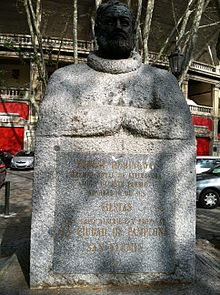San Fermín

San Fermin
Fermín se dice que fue el hijo de un romano de senatorial rango en Pamplona en el siglo tercero, que fue convertido al cristianismo por San honestus , discípulo de San Saturnino . Según la tradición, fue bautizado por Saturnino (en Navarra también conocido como San Cernin) en el lugar ahora conocido como el "Pequeño Pozo de San Cernin"
Fermín fue ordenado sacerdote en Toulouse y regresó a Pamplona su primer obispo. En un viaje de predicación más tarde, Fermín fue decapitado en Amiens , Francia, y ahora es considerado un mártir de la Iglesia Católica .
Se cree que murió el 25 de septiembre del 303 dC.
No hay ningún registro escrito de veneración en Pamplona del Santo hasta el siglo 12.
San Fermín, así como San Francisco Javier , son ahora los dos patronos de Navarra. En Pamplona, San Fermín está a veces dice que ha encontrado su fin al ser arrastrado por las calles de Pamplona por los toros , un destino con mayor frecuencia atribuido a su mentor, Saturnino.
Orígenes
La celebración de la fiesta tiene su origen en la combinación de dos eventos medievales diferentes. Ferias comerciales seculares tuvieron lugar a principios del verano.
As cattle merchants came into town with their animals, eventually bullfighting came to be organized as a part of the tradition. Specifically, they were first documented in the 14th century.
Como los comerciantes de ganado llegaron a la ciudad con sus animales, con el tiempo las corridas de toros llegó a ser organizado como parte de la tradición. En concreto, se han documentado por primera vez en el siglo 14.
On the other hand religious ceremonies honoring the saint were held on October 10. However in 1591 they were transferred to the 7th of July to take place at the same time as the fair; when Pamplona’s weather is better. This is considered to be the beginning of the Sanfermines.
Por otra parte se llevaron a cabo ceremonias religiosas en honor al santo, el 10 de octubre. Sin embargo, en 1591 fueron trasladados al 7 de julio para llevar a cabo al mismo tiempo que la feria, cuando el clima de Pamplona es mejor. Este se considera que es el comienzo de los Sanfermines.
During medieval times acts included an opening speech, musicians, tournaments, theatre, bullfights, dances or even fireworks. Bullrunning appears in 17th and 18th century chronicles together with the presence of foreigners and the first concerns on the excessive drinking and dissolute behavior during the event. The Giant’s Parade was created by the end in the mid of the 19th century. The first official bullring was constructed in 1844.
En la Edad Media los actos incluyó un discurso de apertura, músicos, torneos, teatro, corridas de toros, bailes y hasta fuegos artificiales. Bullrunning aparece en el siglo 17 y 18 relata junto con la presencia de los extranjeros y el primero se refiere al consumo excesivo de alcohol y la conducta disoluta durante el evento. Desfile del gigante se creó a finales de mediados del siglo 19. El primer oficial de la plaza de toros fue construida en 1844.
Modern times Tiempos modernos
The worldwide fame of the modern festival, and the great number of foreign visitors it receives every year, are closely related to the description by Ernest Hemingway ’s book The Sun Also Rises and his job as a journalist. He was greatly amused in his first visit in 1923 coming back many times until 1959 Hemingway was also deeply fond of bullrunnings and bullfights.
La fama mundial de la fiesta moderna, y el gran número de visitantes extranjeros que recibe cada año, están estrechamente relacionados con la descripción de Ernest Hemingway libro ’s The Sun Also Rises y su trabajo como periodista. Él se divirtió mucho en su primera visita en 1923 a volver muchas veces hasta 1959.
Hemingway también era sumamente proclive al bullrunnings y corridas de toros. Different city locations are famous in part due to the fact that the writer used to visit them, such as La Perla Hotel , or the Iruña Café .
Diferentes lugares de la ciudad son famosos, en parte debido al hecho de que el escritor utiliza para visitar, como La Perla Hotel, o en el Café Iruña.
El día más fundamental de la fiesta es el 7 de julio, cuando miles de personas acompañan a la estatua del siglo 15 San Fermín por el casco antiguo de Pamplona.
The statue is accompanied by dancers and street entertainers, and different political and religious authorities including the city mayor. During procession a Jota (an ancient traditional dance) is performed for the saint, a rose is offered in the Saint Cernin well, and the "gigantes" (enormous wood-framed and papier-mâché puppet figures managed from inside) dance and twirl while the cathedral bell named María (Mary) peals.
La estatua está acompañada por bailarines y artistas callejeros, y diferentes autoridades políticas y religiosas, incluyendo el alcalde de la ciudad. Durante la procesión una Jota (una antigua danza tradicional) se realiza para el santo, se regala una rosa en el San Cernin bien, y los "gigantes" (enormes con marcos de madera y papel maché figuras títeres manejados desde el interior) danza y girar mientras el timbre catedral llamada María repiques (María).
VIVA SAN FERMÍN
GORA SAN FERMIN


0 comentarios